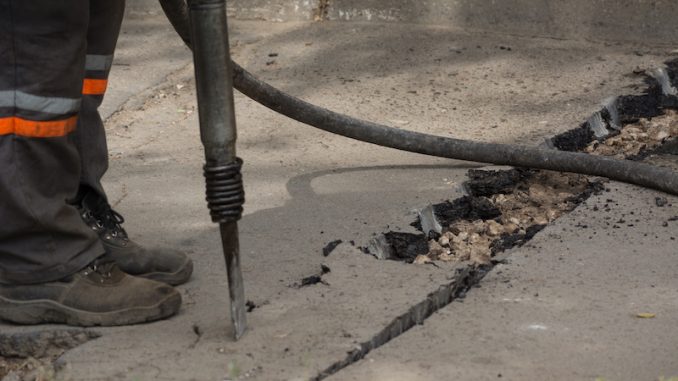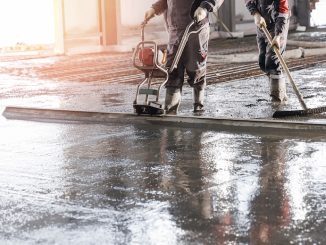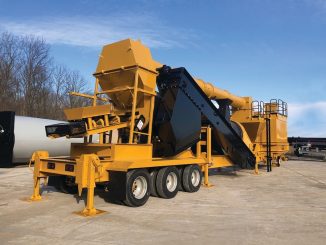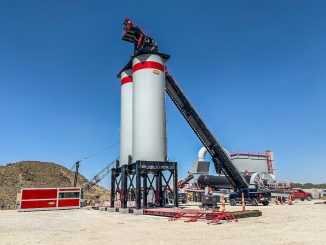
Pavement crack treatment operations should be carefully planned and designed so that the most cost-efficient and effective option is utilized. In addition, the planning process should incorporate other factors, such as the procedures and equipment that must be used based on the condition of the road.
In planning a crack sealing or crack filling treatment, contractors should consider the following factors: 1) climatic conditions, both at installation and generally, 2) highway classification, 3) traffic level and type, 4) the density and characteristics of the cracks, 5) materials, 6) placement and configuration of the materials, 7) procedures and equipment, and 8) safety.
The climate of a particular site during crack sealing or filling operations may influence the procedure or materials used. For example, a heat lance may be used on sites where moisture or cold temperatures present challenges. In hot climates, it may be necessary to use materials that will not soften at high temperatures. By contrast, in severely cold temperatures, a material that retains good flexibility should be utilized.
The classification of a highway and the type and level of traffic present on the roadway are critical in two respects. First, safety during installation is of paramount importance. On roadways with significant traffic or particular geometrics, safety may be compromised. In this situation, it is preferable to apply treatments that last longer to reduce the number of subsequent applications. Second, an assessment of the amount of traffic passing over the pavement, including whether snow plows will make contact with the pavement, must be made if material will be placed in an overband configuration. In these situations, a material that is both durable and flexible will be the best choice.
The characteristics of the crack also play a role in the materials and procedures to be used. These characteristics may include edge deterioration, width, and movement. In addition to crack density, these factors are necessary to estimate the amount of material needed for the project.
Which Sealant or Filler Material Should Be Used?
When it comes to crack treatment options, there are three separate material families, typically grouped by material type. They include cold-applied thermoplastic bituminous materials (such as liquid asphalt and polymer-modified liquid asphalt, hot-applied thermoplastic bituminous materials (such as asphalt cement, asphalt rubber, rubberized asphalt, low-modulus rubberized asphalt, and fiberized asphalt), and chemically cured thermosetting materials (such as self-leveling silicone).
In addition to these three primary types of crack sealing and filling treatments, there are several other materials that do not fall into one of these categories. These include asphalt cutbacks, mineral-filled asphalts, and sand-asphalt mixes. Mineral-filled asphalts and cutbacks are not commonly used. Sand-asphalt mixes are generally viewed as crack repair materials.
Asphalt cement and liquid asphalt are generally only used as fillers for non-working cracks due to their sensitivity to temperature and lack of flexibility. Similarly, fiberized asphalts are generally only used for crack filling treatments, as they lack elasticity.
Once rubber polymer is added to liquid or heated asphalt, its field performance is greatly improved due to added flexibility. The level of flexibility will depend on factors such as the percentage of rubber used, how it is incorporated, and the type and nature of the asphalt. In addition, other polymers may be added to increase resilience.
In recent years, chemically cured thermosetting materials have been used on asphalt concrete pavements. These materials cure via a chemical reaction that takes them from a liquid state to a solid state. An example of a chemically cured thermosetting material is self-leveling silicone. This material contains just one component and is applied cold. It requires no tooling.
In order to select a material for a crack treatment operation, the first step should be to identify the properties that it must possess to not only be placed but to perform successfully over time. Some properties that should be considered in making this evaluation include adhesiveness, short preparation time, good workability, short cure time, cohesiveness, flexibility, resistance to softening and flow, elasticity, abrasion resistance, and resistance to aging and weathering. Materials with rubber-like properties are generally preferred for sealing cracks, while materials that have less elasticity — such as emulsion and asphalt cement — are more appropriate for crack filling.
Beyond examining the properties of each individual material, contractors should consider the actual field performance of each material. This can be done by tracking the results of national and state crack treatment studies, as well as local experiences with material performance.
A cost-effectiveness analysis should be performed in order to ensure that the maximum benefit is obtained from the expense of the crack treatment operation. This process involves adding all costs associated with placing a material compared to the service life of the material.
Before any material is placed, laboratory testing should be performed to make sure that the material has the properties for which it was selected. A sample should be taken from each batch of material shipped and then submitted for testing prior to placement. Any batch that does not meet specifications should be rejected.
How Should Placement Configuration Be Selected?
When treating pavement cracks, sealant and filler materials can be placed in any number of configurations. There are four primary categories of placement configurations that are used in crack treatment. They include 1) flush fill, 2) reservoir, 3) overband, and 4) combination reservoir and overband.
A flush fill configuration involves placing material into an existing crack and then striking the excess material. The crack itself is not cut.
In a reservoir configuration, the crack is cut, and then, material is placed within it. The material is placed either flush or slightly below the surface of the pavement.
An overband configuration involves placing material both into and over a crack. The crack itself is uncut. This material can either be shaped into a band using a squeegee into what is known as a band-aid configuration. Otherwise, the unshaped material is known as a capped configuration.
Finally, a combination configuration is made when a crack is cut, and then, material is placed both into and over the crack. A squeegee is then used to shape the material into a band over the crack.
The decision on what placement configuration for individual cracks to choose is based on four factors: type of application, type of crack channel, strike-off or finishing characteristics, and the dimensions of the crack reservoir and overband. Almost all crack sealing and filling treatments involve applying the material directly to the crack channel. In some cases, a bond breaker material is placed prior to the application of a sealant to prevent it from running into the crack during application and forming a bond with the reservoir perimeter. In this way, the performance of the sealant is improved. This type of application should only be utilized when the costs are lower than the benefits of improved performance, and the working cracks are relatively straight with little edge deterioration.
The shape of the sealant can also have an impact on performance. The shape is defined as the ratio between the width and depth of the sealant. It is controlled by the crack cutting when the material is applied directly to the crack. Otherwise, it is determined both by cutting and the depth to which the bond breaker is placed.
For direct application, a hot-applied rubber-modified sealant is generally recommended. It is not advisable to use this type of this material with a bond breaker given the increased costs. As a rule, silicone is usually recommended for placement with bond breakers.
If a portion of pavement contains a meandering crack, it may be difficult to cut the crack using cutting equipment. Parts of the crack may be missed, which can result in two channels that are adjacent to each other. This can also occur when secondary cracks form along the primary crack. In this situation, a decision must be made as to whether the cut and uncut crack should be sealed or if the uncut crack segment should be sealed, so that both reservoirs can be sealed.
To cut cracks, routers and saws can be used. These tools generally have controls that allow an adjustment to change both the depth and the width of the cut. If a reservoir is particularly deep, a bond breaker can be placed to provide proper shape.
Overbanding is a common placement technique, but its use is dependent on the type of material utilized. Certain materials — primarily silicone and emulsion — cannot come into contact with road traffic. Other materials are less durable and, as such, should be avoided if an overband application is desired. If overbanding is selected as a placement technique, contractors must decide whether to shape it into a band-aid or leave it capped. A capped configuration requires less labor but may not be as effective, as shaping the hot-applied rubber-modified asphalt helps to establish a bond. With a capped configuration, the material often flows and levels out after application. As a result, the bond will typically be weaker, as the material decreases in temperature as it self-levels.
How Should Procedures and Equipment Be Selected?
In a pavement crack treatment operation, there will be as few as two steps and as many as five. The number of steps involved will depend on the type of treatment chosen, the treatment policy, as well as the equipment used in the operation. These steps may include: 1) crack cutting, 2) crack cleaning and drying, 3) material preparation and application, 4) material finishing, and 5) blotting. Of these steps, only steps 2 and 3 are required.
Crack cutting is infrequently required in crack filling operations, but is often necessary for crack sealing. It is done with routers and saws, typically with a high-production machine to minimize damage and the time involved with cutting pavement. Options for routers include vertical- spindle routers, which are highly maneuverable and cause little damage, and rotary-impact routers, which are more productive than vertical-spindle routers but may cause more damage. Generally, carbide router bits should be used as opposed to steel bits. Alternatively, a random crack saw can be used for meandering cracks. This saw follows meandering cracks well and provides smoother walls with more rectangular reservoirs. In locations that experience significant temperature variations, crack cutting is preferred so that a material shape can be achieved that will provide additional flexibility. This flexibility will help withstand crack movements.
Crack cleaning and drying is a necessary step in the crack treatment process with a goal of achieving optimal conditions for the placement of conditions. This step is vital to the success of crack sealing and filling, as many treatment failures are due to adhesion failures from dirty or moist crack channels. Crack cleaning and drying are accomplished in one of four ways: air blasting, hot air blasting, sandblasting, and wire brushing. Air blasting is accomplished with either portable backpack or power-driven blowers or with high-pressure air compressors with hoses and wands. Air blasting works well to remove dust and debris but is less effective at drying the crack channel. Hot air blasting uses a hot compressed air (HCA) lance connected to a compressed air unit. This is an effective method of crack cleaning, as it removes dirt and debris, dries the channel, and heats the surface to enhance bonding. Sandblasting involves the use of a compressed air unit, a sandblast machine, hoses, and a wand with a nozzle. It is a labor-intensive operation that is particularly successful at removing debris and which produces a clean, textured surface ideal for bonding. Finally, wire brushing involves using mechanical, power-driven wire brushes with compressed air to remove debris lodged in crack reservoirs.
The preparation and application of materials is the other required step for crack treatment. For emulsion materials, there are a number of options for preparation and application. These materials can be kept in drums for unheated applications or loaded into distributions for partially heated applications. Pour pots are often used to pour emulsion (heated or unheated) into cracks. The chosen method for both preparing and applying emulsion will depend on what equipment is available, along with the size of the job and whether heating is required.
For hot-applied thermoplastic bituminous materials, heating is usually accomplished via an asphalt distributor or an asphalt kettle. Direct heat systems can be used for unmodified asphalt materials but are not recommended for modified asphalt materials due to the possibility that the asphalt may be unevenly heated or overheated. Asphalt that has been modified with rubber or fiber must be heated and mixed over indirect heat in a kettle with an agitator. This system is safer and offers a more uniform method of heating the material. When determining what type of kettle to use for heating a hot-applied thermoplastic bituminous material, factors to consider include the type of material, size of the job, constraints on preparation time, air temperature during preparation, and safety.
For cold-applied thermosetting materials, a silicone pump should be directly attached to the original material container. These pumps and other applicators should allow the operator to apply the sealant to the crack at a sufficient rate. Ideally, the application hoses and seals should be lined with Teflon to prevent the silicone from curing in either the pump or the hose.
Material finishing and shaping is an optional step but one that is often important. It can be achieved in two ways. First, an attachment can be added to an application so that both application and finishing can be accomplished simultaneously. Second, an industrial rubber squeegee can be used after the material is applied to provide the desired shape. The one-step method is less labor-intensive but does not provide as much control in finishing as a squeegee. Some configurations do not require finishing or shaping (such as capped and recess configurations).
Blotting involves placing a temporary cover (such as toilet paper, sand, or limestone dust) onto the treatment material. This is often necessary to prevent tracking, particularly for asphalt and hot-applied materials. In addition, any material that is subject to traffic before it is fully cured should be blotted. The equipment needed for blotting will depend on the blotter material used. For example, sand can be stored on a truck and spread with shovels, while toilet paper can be loaded on a truck and then placed using modified paint rollers.
There are many factors to consider when planning and designing a pavement repair project. Each of these factors is vital in the overall success of the crack treatment operation. In the next article, we will discuss pavement repair safety, blasting, and material application.
What factors should be considered when selecting materials for pavement crack treatment, and how do climatic conditions and crack characteristics influence the choice?
Consider climatic conditions, crack characteristics (e.g., width, movement), and traffic levels when choosing from material families like cold-applied thermoplastics, hot-applied bituminous materials, and chemically cured thermosetting materials.
What are the key steps involved in planning and executing pavement crack treatment, and why is crack cleaning and drying crucial for the success of crack sealing and filling?
Plan considering factors like highway classification, traffic, and materials; key steps involve crack cutting, cleaning, material preparation, and application; crack cleaning and drying are vital to prevent adhesion failures from dirty or moist crack channels.












































